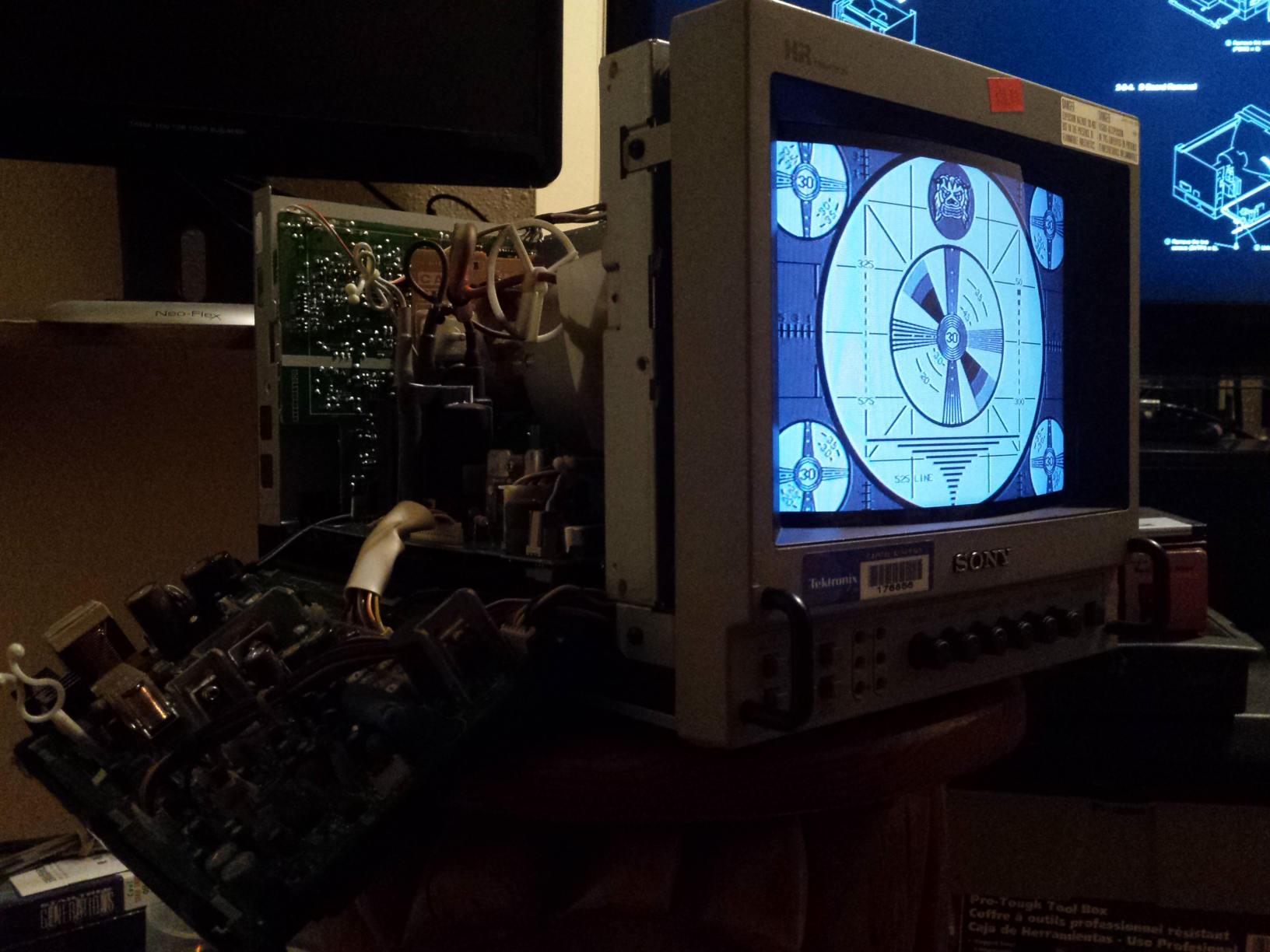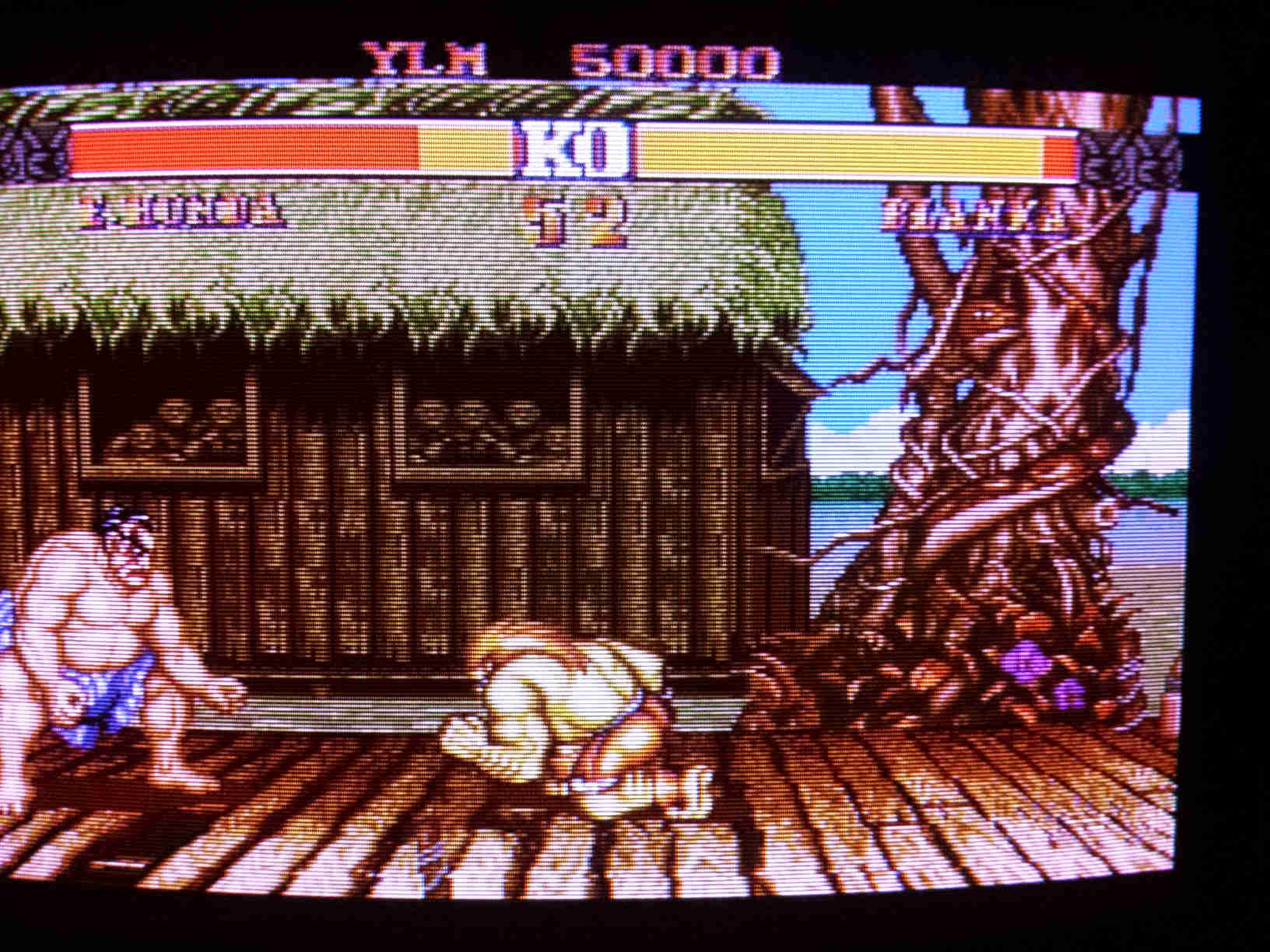Congrats and mad respect! Was reading some of the details in your comments in the other thread. A function generator is definitely on my want list, along with a CRT analyzer (if I happen to find a deal on a good one).
- 1 Post
- 15 Comments

 0·2 months ago
0·2 months agoThe monitor had two obvious problems at first: yellow tint and rainbow patterning. Quick pass with a degaussing coil took care of the latter. Hooked up a composite lead and threw on my low-quality DVD-R copy of my VHS copy of my NTSC Reference Laserdisc and made some quick adjustments to the monitor; results below:

monoscope

SMPTE bars
To make this post somewhat more relevant to the community:

Street Fighter II (PC Engine) Blanka Stage

Street Fighter II (PC Engine) Guile Stage

Street Fighter II (PC Engine) Ryu Stage

Street Fighter II (PC Engine) Zangief Stage
The colors in the game look different in these pictures; hard to make them accurate. But it looks good in person.(edit: better camera settings, more colorful game)Was reaching for my blue filter to set Color/Tint when I remembered this monitor has a “Blue Only” feature; pretty neat! Surprisingly, adjusting the Screen control on the flyback transformer seems to have more effect on the white balance than on the contrast. Still, had to maximize the Blue Gain control on the PCB and on the front panel to get the white balance close as possible for the time being. Heck, I might not actually bother with it much further; it looks pretty good. Will have to try the RGB inputs.

 0·3 months ago
0·3 months agoRight you are; this one’s a PVM-8043MD. Looks like it lacks the 16:9 mode, manual degauss and tally light. I believe MD signifies “medical”; removed the cover and there is some shielding around the deflection yoke.
Thank you for mentioning that model number. That page has some good troubleshooting info relevant to the white balance problem I’m seeing with this one. Will post something nice if I can fix it!

 0·4 months ago
0·4 months agoThought it was odd to call this a sequel to an “NES classic” considering Shadowgate originated on the Macintosh, but judging by the screenshots in the article it seems the authors indeed decided to implement an interface very similar to the one Kemco developed for their NES port. Interesting choice! Having played the Mac-like Amiga port and the NES port I do prefer the controls of the latter as they better suit the use of a keyboard or gamepad.
The music in the NES port is very memorable to me as well. If Beyond Shadowgate will feature sound, I would hope that cues are taken from the sound of the NES and the prior composer’s work.
Developed by The Minnesota Educational Computing Consortium.
For ZSH and SSH I just speak the letters: Z-S-H, S-S-H. Sudo as “SUE-do”.
One I wonder about is xrandr. I say “EKS-rand-ur”, have heard others say “eks-R-and-R”.

 0·4 months ago
0·4 months agoProfoundly nightmarish was mine, here are the highlights:
Go to take LSD for the first time with some friends at the seller’s house. Just about the time the effects are taking over I realize I met the guy once about ten years earlier, when as a stupid kid I accidentally shot him in the face with a pellet spring pistol.
Bit later, on top of feeling ashamed, regretful, worthless, helpless and out of my mind I’m becoming very nauseated so I go to the front porch. In a brief moment I see another guy I hadn’t seen in years walking by on the sidewalk, and reach my hand up to wave at him. As my stomach empties he freezes in his tracks, mid-wave as his smile of recognition turns to shock.

 0·5 months ago
0·5 months agoI imported this game when it first came out and it’s been one of my favorites. Very interesting to think about how the strengths of the Genesis vs. the PC Engine could be used. So far it looks like it’s aimed at graphical fidelity. The PCE had a wider color palette from which to select and could display more colors simultaneously, but I don’t think Rondo really pushed those capabilities. Konami did some really nice parallax routines in this game for the single background graphics layer on the PCE. Those effects are much more common on the Genesis with its multiple hardware layers. Curious as to how the “extra power” could be used if werton opts to explore that. The FM cover tune sounds great, looking forward to hearing more!
What blew me away in the video was the costume change. Was that in the original all this time? I know what I’m playing today!

 0·5 months ago
0·5 months agoFun, spooky, action-oriented*, skeletons, bats: Temple of Apshai from 1983 on the Commodore 64. About two minutes fifteen seconds into the video you’ll see and hear its unique spooky atmosphere.
*for a role-playing game of this vintage, anyway.

 0·5 months ago
0·5 months agoWill probably check it out as I count myself among the Black Isle/Obsidian aficionados. Didn’t see a link to the mod in the article. Bit of a let-down that Yesterday does not seem to implement the 3D Jefferson Engine as was seen in the Van Buren tech demo, but props to these modders all the same!

 4·6 months ago
4·6 months agoMost of Creative’s AWE32 cards do use a real Yamaha OPL3 chip for FM synthesis, which can produce two-or-four operator voices. The latter of those can approach the quality of the voices in their DX7-family line of musical instruments. Even the older OPL2 chip that is limited to two-operator voices can sound great when programmed well (not that I’d call it realistic-sounding).
The other synth chip on the AWE32 is the Ensoniq EMU8000. That one does sample-based synthesis as you describe above.
Just wanted to note that Creative misappropriated the term wavetable synthesis when they marketed this and other sample-based synthesis cards of theirs, and the misnomer spread widely to the products of other companies and persists to this day.

 3·6 months ago
3·6 months agoGreat card, got one in my 440BX retro rig! Plus an AWE64 Gold and a PnP SB16 with a real OPL3 FM chip. That’s just a bit of what’s kicking around here…

 0·6 months ago
0·6 months agoThe article’s a good read. It’s not about the first game from 1987.

 0·7 months ago
0·7 months agoOne of the last of the many great shooters on the PC Engine is the one-or-two-player Ginga Fukei Densetsu Sapphire.

Played the DOS version to completion, enjoying every bit of it. Then the TurboGrafx-16 CD version with its satisfying cinematic reveal of the big plot twist. Really wish I could play more games like this!